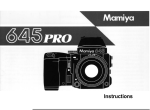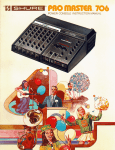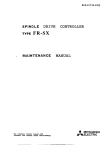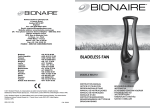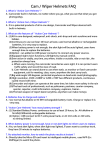Download Mamiya 645 PRO TL Operating instructions
Transcript
Instructions Congratulations on your purchase of the Mamiya 645 PRO TL Mamiya pioneered the 6 x 4.5 film format and introduced the world’s first 645 SLR in 1975. The 645 PRO TL is the latest masterpiece in this series and Incorporates all the latest mechanical, electronic and optical advances. Its external appearance, too, has been modernized and its ergonomic design further enhanced. We are sure that you will enjoy the many advantages this camera and its accessories offer and want to particularly mention : The 645 PRO TL has a built-in self-timer (delayed shutter release) which will also facilitate time exposures. Attaching special leaf shutter lenses will automatically set the focal plane shutter to 1/8 sec. Heavy duty gears connect to the improved Power Drive Grip WG401, This grip also automatically cocks the leaf shutter lenses and permits remote control. The AE Prism Finder FE401, specially created for this camera, automates exposure and shows LED safety signals. 35mm film holders now come with panoramic adapters. A super fast 300mm f/2.8 APO lens was also designed for this camera. We are convinced that your camera will serve you well, because we have designed it for heavy professional use. However, we ask you to please read all operating instructions carefully before you put your equipment to work, in order to ensure proper operation and maximum results This manual covers the basic camera. Separate instructions are supplied with all system accessories, including lenses, finders, film holders, etc. For additional information please feel free to contact your authorized Mamiya dealer or the Mamiya importer in your country. Contents Special Features of the Mamiya 645 PRO TL ....... 3 Names and Functions of Parts .............................. 7 Attaching and Removing Lenses ........................ 10 Attaching and Removing the Roll Film Holders. 11 Attaching and Removing the Viewfinder ............ 12 Removing and Attaching the Film Advance Crank ...................................................................... 13 Inserting the Battery ............................................. 14 Battery Check ........................................................ 15 Shutter Release Selector ...................................... 16 Shutter Performance Test .................................... 17 Before Film Loading ............................................. 16 Film Loading .......................................................... 19 Advancing the Film to the First Frame.. .............. 21 Shutter Speed Settings. ........................................ 22 Aperture Ring/Stop-down Operation.. ................. 23 Focusing ................................................................ 24 Depth of Field ........................................................ 25 Film Advance and Unloading Exposed Film ...... 26 Using the Self-timer/Delayed Shutter Release.. 27 Time Exposures .................................................... 26 Multiple Exposures ............................................... 26 Mirror Lock-up Photography.. .............................. 29 Infrared Photography.. .......................................... 30 Using a Tripod ....................................................... 30 Flash Photography.. .............................................. 31 Holding the Camera Steady and Securely.. ........ 35 Attaching and Removing the Neck Strap.. .......... 36 Basic Accessories ................................................ 37 System Chart ......................................................... 39 Trouble Shooting .................................................. 40 Mamiya 645 PRO TL Specifications .................... 41 Things to Watch .................................................... 43 Common Sense Camera Care and Practice ....... 44 Special Features of the Mamiya 645 PRO TL 1. Image Area about 3X larger than 35mm Format - Bigger is better -The 6X4.5cm image size is about 3x larger than 35mm and therefore produces far superior results. It is large enough to be viewed without magnifier and its aspect ratio of about 1.25 (long side : short side) matche s the standard 8 x 10 inch “ideal format”, the most popular in photography and industrial use. It requires minimum cropping and gives maximum film utilization. (15 or 30 exposures on 120 or 220 film respectively) 2. Rugged, Versatile and Reliable Camera Body - Built for professional use -Mamiya pioneered the 645 SLR camera system in 1975 to create medium format image quality with 35mm handling ease. New models have periodically followed over the years to keep in step with mechanical, optical and electronic advances 3. Interchangeable Rollfilm Holder System -120, 220, 35mm, 35mm Panoramic and Polaroid -Permits quick film change, even in mid-roll. Many fail safe features prevent accidental exposures or film waste. 4. Interchangeable Viewfinders 1. AE Prism Finder FE401 The AE (automatic exposure) Prism Finder FE401 features three modes of TTL metering, including automatic switching from center-weighted averaging to spot metering. It also has a +3EV exposure compensation adjustment. 2. AE Finder FK402 Light weight, Keplerian (non prism) AE aperture priority finder offers an unreversed, upright image Features telescoping eyepiece with diopter adjustment from +5 to -5. 3. Prism Finder PF401 The Prism Finder PF401 is without metering electronics and designed for manual photography mode. Both Prism Finders show an unreversed, upright image and are ideal for eyelevel photography. 4. Waist Level Finder N The Waist level Finder N is desirable for low angle photograhpy and particularly for horizontal composition. A self erecting hood with built-in magnifier shields groundglass from all ambient light. A built-in sportsfinder permits eyelevel viewing and is ideal for action photography. 5. Interchangeable Focusing Screens The camera comes with a Type E, bright, split image, micro prism screen, useful for most applications. Five other types, for all specialized requirements, are also available. 6. Large Selection of World-Class Mamiya Lenses Mamiya’s in-house optical engineering and manufacturing department produces lenses specially designed for the medium format, of unsurpassable resolution, contrast and color fidelity. From 24mm Fisheye to 500mm telephoto, plus macro, zoom and APO lenses, these lenses have become the choice of the pros. 7. Motorized Power Drive Grips Two accessory motorized drives, interchangeable with the manual film advance crank, are incorporated into an ergonomically designed grips for easy, right handed camera operation. Model WG 401 requires 6 AA batteries and features multiple exposure switch, cable release socket, battery check and continuous shooting. It also can be used with leaf shutter lenses. Model WG402, a simplified version, permits only individual exposures, uses one 6 Volt lithium battery and is much lighter. Accessory System 8 . AForBroad Specialized Applications A useful accessory system to serve the specialized needs of the photographer. It includes Auto Bellows and Auto Extension Rings for close-up and copying work; Infrared Remote Control for studio and nature photography; External Battery Case for operating in cold surroundings; Camera Grips for convenient holding and more. <Self-timer> Self-timer for delayed shutter release. When activated it will light a red pilot lamp in the front of the camera for eight seconds and will blink for two seconds before triggering the shutter. <Time Exposure> Time exposures are made by utilizing the Self-timer and the "B" shutter setting. A new power saving circuit design switches the battery off and extends is life. 9. TTL (through-the-lens) Flash Exposure Automation The light that hits the film surface during exposure is reflected to a photoreceptor within the camera body which automatically adjusts the flash output to the required level. 10 . Other Features <Mirror Lock-up> After focusing, the mirror can be locked up before making an exposure. This is convenient when the camera is used at slow shutter speeds and is mounted on a tripod for telephotography, copywork, etc., since even a very small amount of vibration should be eliminated. <Self-timer> Shutter will be released 10 seconds after shutter button is pressed. <Time Exposure> When making time exposures, the battery circuit is automatically disconnected, to save battery power. This is especially useful for astrophotography. Names and Functions of Parts @ 13 Gold Plated Contacts These contacts interface the AE Prism Finder with the IS0 dial on the film holder and the shutter speeds. Focusing Screen N Aperture Ring Coupling This pin is fitted into the E Meter Coupler of the l transmit the aperture dat AE Prism Finder. Hot-shoe (X contact) A cordless flash can be used with this shoe. Battery Check Lamp Focusing Screen Release Pin When you want to change the screen, slide this pin to the left and remove the screen. Flash Sync Terminal Flash cord and optional Terminal Adapter RA401 can be connected to this terminal. Shutter Release Selector Align the white index dot on the selector collar with the white square dot in the center for normal use. When the collar is turned to the red dot, the release is locked. To use the Self-timer, set it to e.. Shutter Release Button left, the contact appears. This contact is used for connections of external releases such as a Mirror l Never touch the surface of the mirror Battery Check Button/ LED displays the present battery condition. 0 \ tro’ u”it. Coupling Connector for 6- Pin dedicated TTL flash automation. (Such as Metz SCA396) Finder Coupling Panel (Front) tl Finder Coupling Panel (Rear) /’ S h u t t e r S p e e d Dial L o c k Release Button This button is used for unlocking the Shutter Speed Dial from an AE position This contact receives film sensitivity data from the film holder. Film Holder Mount Shutter Curtain Exposures are controlled by opening and closing the curtain: a Never touch the surface of this curtain. Film Transport GearFilm Holder Mounting Bracket Multiple Exposure Lever When this lever is set at "MULTI", film is not advanced even when the Film Advance Crank is turned, thus allowing multiple exposures on the same film frame. Distance Scale The camera to subject distance can be set or confirmed with this scale Lens Alignment Dot Depth-of-field Scale Provides a quick reading of depthof-field for various apertures and distances. Exposure Meter Coupler This coupler is engaged with the Aperture Ring Coupling Pin, transmitting diaphragm information to the AE Prism Finder. Tripod Socket 1/4’ tripod socket. To convert to a 3/8’ socket, remove the small screw in the base of the socket. Then remove the bushing. See page 32. @ Attaching and Removing Lenses 0 Removing the Front Body Cap and Rear Cover First remove the Front Body Cap in the direction of the arrow, while pushing the Lens Release Button 8 backwards as indicated by arrow. Rear Body Protective Cover can be readily removed by depressing the part of @ as shown in the illustration. Attaching the Lens Removing the Lens. Line up red Lens Alignment Dot 0 against red camera Alignment Dot $3 and gently insert the lens into the camera body. Then turn the lens clock wise, as indicated by arrow, until it clicks into place. Make sure that the Aperture Ring Coupler Pin is engaged with the Exposure Meter Coupling Pin @I,, which sticks out under the Mamiya name plate of the camera. While pushing lens release button @ backwards, turn lens counterclockwise. (Same procedure as removing body cap). Attaching and Removing the Roll Film Holder Removing the Rear Body Cap Attaching the Roll Film Holder Rear Body Protective Cover can be readily removed by depressing the part of 0 as shown in the illustration. * Remove the Roll Film Holder Cover. 1. While spanning the Roll Film Holder between your thumb and middle finger, holding it on the rubberized finger rests, carefully align its Film Holder Mounting Bracket with the corresponding center clip of the camera body. *After removing the rear cap, be careful not to touch the shutter blind. This can cause breakage of shutter. 2. While keeping this alignment, press the upper part of the Roll Film Holder against the camera body, so that it clicks into place by engaging the spring loaded twin camera catch. Attaching and Removing the Viewfinder Removing the Roll Film Holder Attaching the Finder. Removing the Finder 1. Insert the Dark slide into the slot marked by White Lines on the side of the holder. 2. Push the lower one of the Film Holder Detaching Lock Release Button @ downward, while simultaneously pushing the Film Holder Detaching Button @$ inward. Lift the Upper Cover from the camera body. Insert the Attaching Latches of the finder into the Finder Coupling Panel @I in the front wall of the body. Press the finder down until the rear latch locks securely in place. Spanning the finder with your fingers, push the button on its right side marked with a downward pointing arrow @ @I, downward, while pushing the other button, on the left side @ 0, inward. * If the Dark Slide is not inserted, the safety lock will prevent the holder from being removed. Removing and Attaching the Film Advance Crank Removing the Crank Attaching the Crank Push the lock Lever ‘&> on its bottom in a forward direction as far as it will go (see illustration). With the flat part, having a White Index Line, on top, line the Crank up against its mounting plate on the side of the body and push Film Advance Crank Lock Lever backward. You may choose six different crank starting positions to suit your preference. The orientation of the crank proper against its base, before it is attached to the camera, will be maintained when the entire assembly is locked into place. 0 Inserting the Battery The camera will not function without a battery With your fingernail, pull the Battery Chamber Cover latch, on the bottom of the camera body, as indicated by the arrow in the illustration. Lift the cover off. The camera requires a 6V alkaline, silver oxide or lithium battery. It is a good idea to wipe the battery terminals before insertion to assure proper contact. Observe polarity. Q position is marked in battery cavity. Insert the G side first at a steep angle and then push entire battery into place, making sure that the lift ribbon wraps around battery. Close cover by inserting twin-prong end first and pushing it down. * Be particularly careful not to let the lift ribbon cover the c” terminal. Batterv Check Press Battery Check Button “B.C.” 8 on lower front of the camera. Battery Check Lamp @I on top opposite side should light. Bright light indicates good condition. Blinking light means replace battery. No light means battery is dead or improperly inserted. Important: 1. The sealed, new battery which is supplied with this camera may have been subject to storage conditions which have reduced its service life. Therefore it is desirable to replace it with a fresh battery as soon as possible. 2. Carefully wipe the battery contacts before inserting into the chamber. Failure to do so may result in poor electrical contact and consequent malfunctioning of the camera. 3. Always remove battery when camera is not used for a while. Always carry spare batteries. 4. Battery life differs, depending on type, age. storage condition, ambient temperature, frequency Of use etc. Battery strength will be indicated by whether the light: Glows ... Battery stength is sufficient. Blinks ... Battery capacity has dropped below the allowable level. (Replace the battery.) Does not light .,..... The camera will not work. (Replace the battery.) Shutter Release Selector When set to the yellow clock symbol ti’ the self-timer is operative. See page 27 and 28 for further instructions. Operating the Shutter Release Button 1. The Shutter Release Button SJ For normal operation set the White Dot of the Shutter Release Selector (8 against the White Square Dot 0. When set to the Red Dot 0, the Release Button is locked. * Select this mode if the camera will be idle for a period and to prevent accidental shutter release. Also when the Power Drive Grip is used. functions in two steps. Gentle pressure will light the metering information display if the AE Prism Finder is used. Continued pressure will release the electromagnetic shutter. 2. If the film is not completely advanced, if the Dark Slide is not withdrawn or if the battery is dead, the shutter will not function, even when the Shutter Release Button is pressed. This will also be the case if the Shutter Speed Dial is set to “A” or “AEL” when the AE Prism Finder is not attached. a3 3. After releasing the shutter, the Film Advance Crank will automatically unlock and be ready to advance the film. Shutter Performance Test 1. Attach the Roll Film Holder to the camera body. 2. Pull out the Dark Slide and place it into its Storage Slot. 3. Set the Shutter Speed Dial to any other position than ‘A”or “AEL”. When the AE Prism Finder is not mounted on the camera, the shutter will not release if the Shutter Speed Dial is in the “A” or “AEL” position, the film holder is supplied with a vinyl tube. When placed in the take-up compartment it engages the film sensor and makes the holder function as if it is loaded with film. Please remove the tube 4. Set the Multiple Exposure Lever on the body to the “MULTI” position. Before Film Loading Film Speed (ISO) Dial Memo Clip r ,I- ! -I L 5. Set the Shutter Release Selector to " 0 " (normal mode), and press the Shutter Release Button. 6. After the shutter has been released, advance the Film Advance Crank one complete revolution and the next frame will be ready. Film Speed Index of film holder Each film holder has this important feature. It electronically interfaces the film holder with the AE Prism Finder, the focal plane shutter and the lens diaphragm, for exposure automation. This eliminates the need of having to manually reset the meter, every time you change film holders loaded with different films. Therefore make it a routine to always set this dial with the speed of the loaded film. IS0 25 The Memo Clip on the back of the Roll Film Holder Cover accepts the box top of the film carton and can also be used for other reminders. 800 1600 3200 50 100 200 400 6 4 0 0 (32)(40) (64)(80) (125)(1601 (X0)(320) (5001(6401(10001(1250) (2ooo)c25oo,(4oao)(sooo) 0 Film Loading 1. While pushing the Back Cover Lock Release Button 8 downward, press the Back Cover Opening Button @;:, and the Back Cover will open. 2. While squeezing in on both sides of the Release Latch CQ, pull the Roll Film Insert out of the camera body. At that time, move the empty spool in the upper part down to the lower spool compartment When you load film for the first time, remove and discard the protective paper cover which is attached to the film rails in the roll film holder. 3. Align the right-hand side of this empty spool with the lower Spool Stud ‘8 (convex). Slide the spool into position making sure that the leftside of the spool is properly held by the Spool Clip. 4. In the same manner, insert a roll of film in the upper compartment. At that time, check that the film leader paper is set as shown in the photo above. (The leader paper inside is facing outward on the pressure plate. Note that the film direction is wrong if the leader paper is facing inward.) 5. Pull out some of the leader paper. Insert the tip of the leader paper into the slot of the lower Take-up Spool. 6. Gently rotate the take-up spool as shown in the photo until the start mark on the leader paper is aligned with the start mark (a) on the spool clip. * Correctly align the start marks with each other, making sure that the film feeds properly. When improper feeding occurs, the proper number of exposures may not be taken. * Avoid exposing the film to direct sunlight when inserting or removing film. @I * 220 Film Loading Caution 220 films have two types of Start Mark Lines across the paper leader. Always use the second one, a solid line with the legend “Start Mark for standard cameras”, located about 14cm (5 1/2”), behind the first, dotted Mark line. DO NOT use the dotted line for a start mark. Advancing the Film to the First Frame 7. Insert the loaded Roll Film Insert into the holder, the film roll on top, while squeezing on both sides of the Release Latch Cc as shown in illustration. Make sure that is been properly seated and is locked in place. Then close cover by firmly pressing its top against the Roll Film Holder. * To close the Back Cover, firmly press the top of the back cover on both sides. 1. While spanning the Roll Film Holder between your thumb and middle ,. finger holding itit on the rubberized finger rests, carefully align its Film Holder Mounting Bracket with the corresponding center clip of the camera body. 2. While keeping this alignment, press the upper part of the Roll Film Holder against the camera body, so that it clicks into place by engaging the spring loaded twin camera catch. Set the multiple exposure switching lever A to the white square mark 0 (normal mode). Shutter Speed Settings I / 3. Wind up. Wind up the crank handle until it stops. In the film counter window, the number 1 appears, and the film and shutter are set. I I How to set the Shutter Speed Dial 1. Set the desired shutter speed against the white index line (A) on the shutter speed dial. 2. At the red “A" (for Automatic) and AEL (for Automatic Lock) settings, the shutter speed dial is locked between these two positions. These settings will only function if an AE Finder is mounted on the camera. To release this lock push button (B) while turning dial. 3. All while numbers are fractional seconds. (i.e. 30 =1/30 sec). @ The yellow 2 and 4 are full seconds. “B” (shutter stays open as long as it is depressed) is also yellow. 4. Red 60 is 1/60 sec. It is colored red to remind you that it is the fastest speed useable with electronic flash. 5. Note: When a Metz Electronic Flash Unit, together with SCA 396 module, is attached to the camera, the camera sets itself automatically to 1/60 sec., irrespective of the dial setting. * When manually selected shutter speeds are set on the shutter speed dial, the intermediate shutter speeds available in the AE operation are not obtainable. Aperture Ring/Stop-down Operation * When the AE Finder is used, be sure to return the A/M lever to “A” (Auto), after having checked the effect of the manually set aperture. The AE finder measures the required exposure through the lens at maximum aperture and will give false results if lever is left in “M” position. Set the desired f/stop on the aperture Ring 6) by aligning the f/number with the red reference dot SC@ in the center of the Scale Ring. The Aperture Ring has a click stop for each f/ stop. In-between settings can also be used. The effect the set f/stop will have upon the picture area can be confirmed on the Finder Screen. Move the AM Lever on the lens so that “M” becomes visible-the lens then can be stopped down to the preselected aperture. 0 Focusing 4B While looking through the viewfinder, turn the lens Focusing Ring until the most important subject part appears sharp and clear. Focusing with the Standard Focusing Screen N Type E r- 1. The camera comes equipped with a bright, Type E, Rangefinder/Microprism Focusing Screen. It features a center, split-image rangefinder spot and the subject is in sharp focus when the split images combine into one. 2. The microprism ring around the split-image center further facilitates focusing. The microprisms disappear only when the subject is in sharp focus. 3. The rest of the ground glass area can also be used for focusing. *Interchangeable F o c u s i n g Screens There are five additional focusing screens available for specialized applications. They are easy to interchange and come with instructions. Depth of Field Reading the Depth of Field Scale Depth of field is defined as the zone of sharpness before and behind the plane of focus. It depends on camera subject/distance, focal length of lens, aperture setting and distance the lens is focused at. ~11 16 22 1 I In addition to visual observation, the Depth of Field can be determined by using the Depth of Field Scale on each lens. f/stop numbers appear on both the right and left side of the red index mark in the center of the scale ring. Simply read the figures which appear above the f/stop numbers on the distance scale of the lens. For example, with the 80mm f/2.8N lens focused at 3m and the aperture set at f/22, the depth of field scale indicates that the zone of sharp focus will extend from about 2m to 6m. Film Advance and Unloading Exposed Film Film Advance Unloading Exposed Film * Move the empty spool from the top to the lower (take-up) compartment, ready for loading the next film roll. *Never load, unload or handle film in direct sunlight. 1. Giving the Film Advance Crank one complete turn, will cock the shutter and mirror and ready the camera for the next exposure. 2. When the film is completely exposed (15 exposures on 120, 30 on 220 film), the crank stop will disengage. Continue turning until the paper trailer is completely wound onto the take-up spool. (About five turns after the last exposure.) 3. Open the Back Cover, and remove the Roll Film Insert. The Exposure Counter will return to S (start) automatically. 4. Pull the Spool Clip on the roll film insert out to remove the film. 5. Remove the film from the roll film insert; make sure that the film on the roll does not loosen, and seal immediately. Using the Self-Timer/Delayed Shutter Release To use the Self-Timer, set the Shutter Release Selector to @ and press the Shutter Release Button. The Battery Check Lamp will light for 8 seconds and blink for 2 seconds, whereupon the shutter will go off. * After using the self-timer mode, be sure to return the Shutter Release Selector to the White Square. (Normal mode.) -k To override the self-timer, after having pressed the release, move the selector back to the white square. * The Self-Timer can also be overridden by inserting the Dark Slide into the Film Holder or setting the camera Shutter Speed Dial to “B”. Please note: If you want to use the self-timer with the shutter speed dial set at “A” or “AEL” and there is no AE Finder attached to the camera, it will not release the shutter even though the light goes on for 10 seconds. However, when the dial is set to manual speeds, the selftimer will function. Time Exposures For time exposures set the Shutter Release Selector to c, the self-timer mode, and set the Shutter Speed Dial to "B". Press the shutter release and both mirror and shutter will stay open until the shutter release is pressed again. You may also use a cable release together with the cable release adapter. (The battery circuit will automatically switch off to save power.) Multiple Exposures * "B" can be terminated by shifting the Shutter Release Selector from 23 or the Shutter Speed Dial from "B" Aligning the white dot of the Multiple Exposure Lever with the yellow “MULTI” square, disengages the multiple exposure prevention mechanism, and the film will not advance after an exposure is made and the Film Advance Crank is turned. However, the shutter will be recocked, thus making multiple exposures possible. In this mode the Exposure Counter will not advance. Mirror Lock-up Photography * To override the multiple exposure mode or to return to normal operation, be sure to return the lever’s White Dot against the white square and then advance the film. (If you forget you will continue to make multiple exposures on the same frame.) This is an important feature when the tripod mounted camera is used at slow or long exposure times and particularly also with use of long telephoto lenses. It eliminates the possibility of even the slightest “mirror bounce” which may affect image sharpness. Move the Mirror look-up Lever to the yellow ”M.UP” square, after you have composed and focused your picture. This will raise the mirror and the viewfinder image will be blacked out. After use, return lever to normal (white square) position. @ *When using the AE Prism Finder, set the Shutter Speed Dial to “AEL”. Press the shutter release halfway and then lock the mirror up. If set to “A” and the mirror is locked up, “LT” (long time) will appear in the finder display and correct exposure cannot be obtained. * When using a Leaf Shutter Lens, be sure to read the instructions accompanying it. Infrared Photography Infrared light rays-being of longer wavelength - focus at a slightly different plane and require the following adjustment: 1. Note the Red Index Mark against which you read your distance scale. The red infrared index mark is slightly to its right. 2. After focusing in the usual manner, read the distance scale and move it to the right to line up with the infrared index mark. @ Using aTripod @ 14 56 8 11 1621 The 300mm and 500mm APO lenses for Mamiya 645 cameras, being also corrected for infrared light rays, do not need an index mark for infrared. * For proper filter and exposure information be sure to consult the instructions enclosed with infrared film. The Mamiya 645 PRO TL Tripod Socket accepts a standard 1/4” tripod mounting screw. For use with tripods having 3/8” mounting screws, first unscrew the small black philips head retaining screw in the center of the tripod socket. Then remove the 1/4" bushing with a thin coin. To re-install the 1/4 bushing, reverse the process. Flash Photography In addition to its standard flash sync system, the Mamiya 645 PRO TL features TTL (through the lens), off the film (OTF), electronic flash exposure automation. A flash sensor located inside the camera body reads the flash reflected from the film surface at the moment of exposure. The .sensw is connected via coilcords to a dedicated electronic Metz SCA 396 thyristor module, which is attached to the flash shoe of the camera. The module has an IS0 dial on which the speed of the film in use is set. The resulting flash exposure automation determines correct flash exposure and automatically adjusts the output of the flash. It also automatically corrects for exposure compensation ordinarily required when using filters, closeup bellows or extension tubes. However, as all TTL systems, it requires manual compensation for differences in film surface reflection characteristics. Compensation is made by adjusting the film speed selector setting an SCA 396 module. The amount of compensation is determined by experimentation. Important: Read Operating Instructions which are supplied with flash unit before use. Always turn off camera’s power switch when attaching or removing flash units. Attaching Metz Flash Units Metz flash 60CT-4/45CL-4 Various optional accessories are needed to attach different Metz Flash Units to the Mamiya 645 TL Metz shoe mount flash type Metz flash 50MZ-5 This table shows accessories required with various Metz Flash Uunits I SCA396 adapter IF? Metz Flash Units SCA300 adapter 3 Bracket AD401 E’ Double shoe adapter AD402 0‘ --.-.-__~-_---.- -_----.__---. _--- _-.-.~---~_-~- -. _.- Shoe mount flash “,“;$; flash 60CT-4 50MZ-5 45CL-4 40MZ-3 40MZ-2 32MZ-3 32Z-2 m Yes No No No Yes Yes No Yes Yes No Yes No No No _---_---~.-No No Yes Yes No No No Yes No No No - TTL Flash Photography with Metz Flash Units 0 0 1. Attach a Metz flash unit which features TTL function to the camera. Attach the SCA396 module to the camera’s flash shoe. Connect the module’s coiled cables to the camera and the flash unit. Set the film speed dial on the SCA396 module to the IS0 rating for the film in use. The range of IS0 is 25 to 1250. 2. Move the flash unit’s power switch to ON and the mode selector to TTL. 3. Turn the camera’s shutter release selector switch to ON. When the charge cycle is completed you will see an illuminated green 5 readylight in the middle of the right side of the finder. When the SCA396 module is connected, the camera’s focal plane shutter will automatically set at 1/60 sec, and ignore the settings on the shutter speed dial between 1/60 to 1/1000, including A and AEL. Slower shutter speed settings, however, (1/30 to 4 sec.) are not affected and will allow flash synchronization. 4. Set lens to the desired f/stop and shoot. After the exposure is made, the illuminated green f blinks, confirming proper flash exposure. If the illuminated green f does not blink after exposure, it is possible that aperture selected is not within the exposure/distance range of the flash. In this case, select a wider aperture setting. When using flash at maximum distance, which requires the full power of theflash unit, recyling time will be longer. Wait for the readylight to go on before firing the next frame. Exposure Compensation with TTL Flash Automation. Because TTL Flash automation reads the light reflecting off the subject, exposure may require manual adjusment in cases where subject and background are predominantly white or black (e.g. bride in white dress against white background; bridegroom in tuxedo against dark background.) In these instances, the resulting TrL exposure will either be under-exposed or over-exposed. For such situations, adjustment of about 1 to 1 l/2 f/stops, plus or minus, may be requiredthroughexperimentation. Alternatively, a hand held incident flash meter reading will show proper exposure in these cases. Photography with Non-TTL Flash Units <Caution> When using the Hot-shoe, be sure to put an appropriate Safety Cover over the X-sync terminal so that you won’t receive a high voltage electric shock if the terminal is accidentally touched. (A Safety Cover is put on the Xsync terminal when the camera leaves the factory.) 1. When using an electronic flash, plug the synchronization cord into the Sync Teminal and set the Shutter Speed Dial to 1/60 sec. or slower. * The Mamiya 645 PRO has an Xsync terminal. Attach a shoe-mount flash to the hotshoe of the camera or the Left Hand Grip GL401 (optional). Flash synchronization Chart * Do not use a flash unit specifically dedicated for another camera. It may damage your 645 PRO. * If you use a flash unit whose flash duration is slower than 1/ 1000 sec., set the shutter speed dial to 1/30 sec. or slower. @ Holding the Camera Steady and Securely h Eye-level Operation Hold the camera as shown in the illustration, with its base resting on your left hand, the right hand supporting it from the side and top. Press both elbows against your body and activate the shutter release with a smooth, steady pressure. Waist Level Operation For waist level operation, it is deslrable to have the Neck Strap attached and adjusted for your size. During exposure keep it taut and press the camera firmly against your body. * Handholding the camera is even easier using the Power Drive Grip WG401 or Left Hand Grip GL401. Attaching and Removing the Neck Strap Attaching the Strap to the Camera 1. While pushing down, pull out the Neck Strap Fastener @ of the attaching clip. 2. Place the hole of the strap fastener @I over the Neck Strap on the camera body as illustrated, and pull until it clicks and locks into place. With your fingers, pull the Neck Stra P Fastener @I of the attaching clip upward and push part @I in the direction of the arrow. The strap can now be removed. * When attaching the Strap to the Neck Strap Lug on the side of the camera with the Film Advance Crank, insert the neck strap fastener @ into the lower part of the double slot. Basic Accessories The AE Prism Finder FE401 The Mamiya AE (Automatic Exposure) Prism Finder FE401 pentaprism guarantees a true, upright image and features built-in electronic shutter control which ensures aperture-priority, TTL automatic exposure metering while in the A or AEL mode. <3-Way Metering System> The FE401 comes with three metering modes: average metering (AV), spot metering (SP). and AV-SP metering capable of automatically selecting AV or SP according to subject conditions. The LED display in the viewfinder indicates correct exposure. If you forget to extract the Dark Slide when the finder is being used with the 645 PRO TL, an LED will flash a warning. Power Drive Grip WG401 The motorized film transport mechanism is placed in an ergonomically designed handgrip for speedy (2 f.p.s) and continuous shooting. Features include cable release socket, shutter release lock, multi-exposure switch, first frame advance, battery check, and power connector socket for leaf shutter lenses. Uses 6 AA 1.5 V. batteries. AE Reflex Finder FK402 This aperture priority, Keplerian type, automatic (AE) reflex finder features TTL auto or manual exposure with center weighted averaging. It offers upright, eyelevel viewing with unreversed image. Exposure is indicated by red and green LEDs.. A built-in adjustable diopter eyepiece can be set from +/-5 for viewing convenience without eyeglasses. Power Drive Grip WG 402 This simplified, compact, lightweight grip uses one 6 V. lithium battery. It has a shutter release with lock and offers single frame exposure mode. / Roll Film Holders 120 Roll Film Holder HA401 220 Roll Film Holder HE401 135 Roll Film Holder HC401 (with Panoramic Adapter) Polaroid Land Pack Film Holder HP401 Metz TTL Flash Unit Shoe Mount 60CT-4 etc. Handle Mount 40MZ-3 etc. Flash Bracket AD401 I Interchangeable Lenses Wide-angle Lenses : 35mm f/3.5N. 45mm f/2.8N, Telephoto Lenses : 150mm f/3.5N, A150mm 55mm f/2.8N f/2.8, 210mm f / 4 N ULD300mmf/5.6N,A200mm f/2.8 APO, A300mm f/2.8APO, A500mm f/4.5 APO/500mm f/5.6 Standard Lenses : 80mm f/1..9N, 80mm f/2.8N, Zoom Lenses : Zoom 55 - 110mm f/4.5N, Zoom ULD105 1 210mm f/4.5 Special Effect Lenses : Fish-eye ULD24mmf/4 Shift 50mm f/4. Macro 80mm f/4N Macro 120mm f/4M Leaf Shutter Lenses : A55mmf/2.8N/L,A80mm f/2.8N/L, A150mm f/3.8N/L Tele-Converter : 2 x Tele-Converter System Chart PnSm FiIlder FP40, AE Fl”&l FK402 wa,st Level Fin&i N Trouble Shooting * If the camera should fail to function properly, please check the following: 1. The Shutter Release Button cannot be depressed. Push the Battery Check Button. If the lamp does not light, check: Is a Battery in the camera? If yes, is it correctly inserted? (Polarity) Is it dead? If the lamp does light, check: Has the Film Holder Dark Slide been pulled? Is the Shutter Release Selector in the locked (Red Dot) position? If so, move it to the White Square and try again. Is the Shutter Speed Dial in the “A” or “AEL” position? If so, turn to other setting and try again. 2. The finder is black or very dark. Has the Lens Cap been removed? Is the Mirror-up Lever in the “M.UP” position? If so, turn the lever to the White Square. Is the “AM” setting on the lens at “M” (Depth of Field Preview)? If so, move it to “A”. 3. The Roll Film Holder cannot be removed from the camera body. Insert the Dark Slide. 4. The developed film has fewer exposures than Specified. Most likely the Start Mark had not been aligned properly when the film was loaded. (See load ing instructions page 20) 5. The Film Advance Crank continues to turn and does not stop. Was the Roll Film Insert placed in the Roll Film Holder? Was the empty fim spool left in the upper compartment? Mamiya 645 PRO TL Specifications Camera type 6X4.5cm electronically focal-plane shutter SLR Actual negative site 56mm X41.5mm Film type 120 roll 220 roll Polaroid 135 roll film (15 exposures) film (30 exposures) pack film (Polaroid 100, 600 series) film in film cartridge - Film loading Daylight loading Standard lenses Mamiya-Sekor C 80mm f/2.8N Mamiya-Sekor C 80mm f/1.9N interchangeable film holders with film speed dial Lens mount M645 bayonet mount (applicable to all M645 lenses) Shutter Moving coil, electronic controlled focal-plane shutter Shutter speed (Manual) 4 sec. -1/1000 sec., B (T) (Auto) 8 sec. - 1/1000 sec. (When the AE Finder is used.) Shutter release Electromagnetic release. Selectable release lock or self-timer mode. Mirror Instant return, front coated mirror, with mirror lock-up capability. Viewfinder Interchangeable (Waist Level Finder N, Prism Finder FP401, AE Prism Finder FE401 and AE Finder FK402) Focusing screen Standard: Rangefinder Spot/Microprism with Fresnel Lens,accessory screens available. (Same as the M645 Super) Field of view 94% . Things to Watch * When using the AE Prism Finder FE401 When using this finder it is imperative that the Film Speed Dial on the Roll Film Holder is properly set for the IS0 number of the loaded film, as it interfaces with this finder. If not done, wrong exposures may result. * When the mirror is locked in the up position. The Focal Plane Shutter Curtain may be damaged if the camera faces strong light sources, especially the sun. Return mirror to normal position or use lens cap to prevent such damage. Common Sense Camera Care and Practice Your Mamiya 645 PRO TL is a precision mechanicaloptical-electronic instrument, built for heavy and reliable professional use. It will reward you with a long service life if properly treated and maintained. Please observe these common sense rules: * Read instructions before using camera. * Protect camera against shocks and falls. Use neckstrap supplied with it, whenever possible. * Protect camera against rain and moisture. If it gets wet, wipe it with a soft, clean cloth. * Do not touch lens or mirror surfaces. To remove dust use air blower or lens tissue. To remove fingerprints use lens tissue and lens cleaning fluid if necessary. * Do not touch gold plated contacts on camera body, lenses, rollfilm holders and AE Finders. If necessary. wipe them with a clean, dry cloth. * Operate the film advance lever with even, measured strokes, to assure proper spacing. * Always test your equipment before going on important assignments. + Do not store camera at temperatures exceeding 40% (lOYF)and-lO’C(15”F)andprotect it against humid or sea air environment. * Periodically exercise your camera and lenses by making blind exposures at various shutter speeds. Also move the diaphragm ring and focusing mounts of all lenses repeatedly. Battery Advice : * The battery supplied with the camera by the factory may have been subject to storage conditions which have reduced its service life. Check it before use and always carry spare batteries. Be sure to wipe battery contacts before inserting it, in order to insure proper contact. Be sure to observe proper polarity. (Match +pole of battery with +mark in battery chamber.) Battery life varies, depending on make, frequency of use, age, storage condition and ambient temperature. (Place battery in External Battery Case accessory which you wear inside your clothing, when photographing in cold climates) * Always remove the battery when camera is not used for longer than a few weeks and store it in a cool, dry place. Storage * When storing camera : Turn shutter release selector dial to the red dot. (Off position) Leave shutter and mirror in uncocked position. The same applies to leaf shutter lenses. @ Special Advice To Professional Photographers Your Mamiya 645 PRO TL is designed for heavy professional use and will give you a long service life if properly maintained. Your camera and lenses have many moving parts which require periodic lubrication. Its electronic components, too, are subject to wear and tear and are affected by ambient conditions like dust, sand, sea air, heat and moisture. If cameras had odometers like automobiles. it would be easier to specify servicing schedules. May we suggest that if you shoot thousands of film rolls per year, you send your equipment annually for servicing by the Mamiya distributor in your country














































